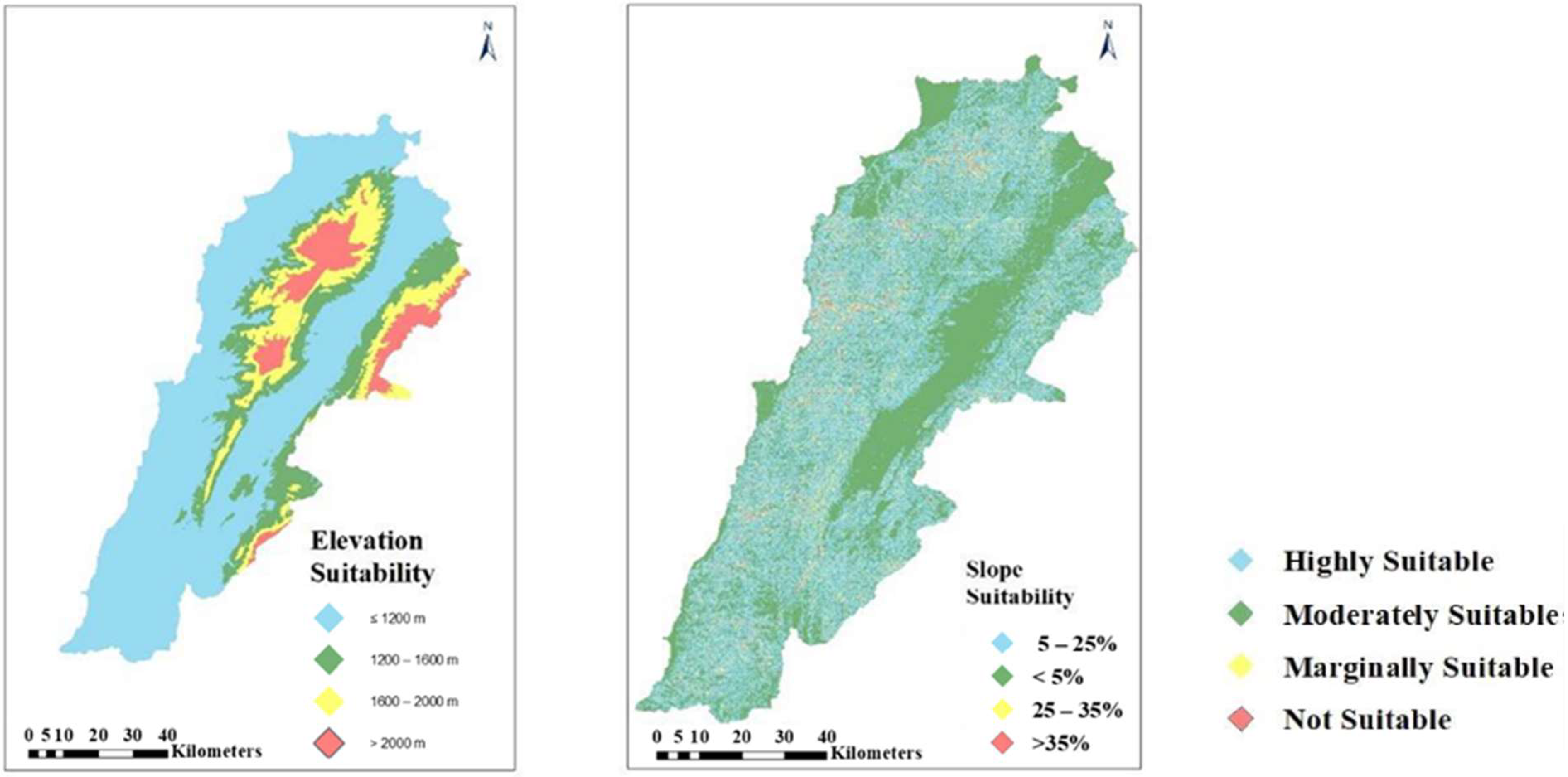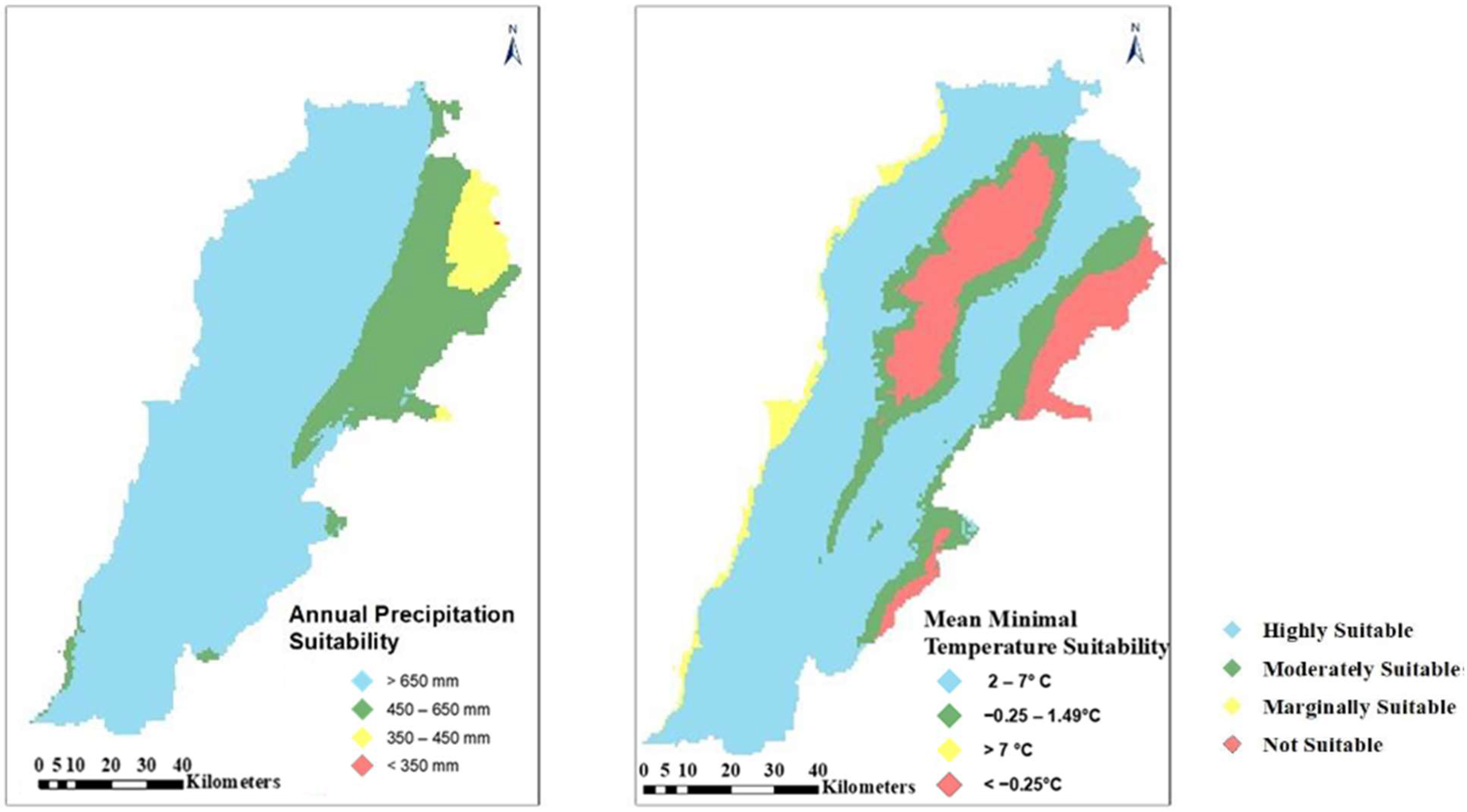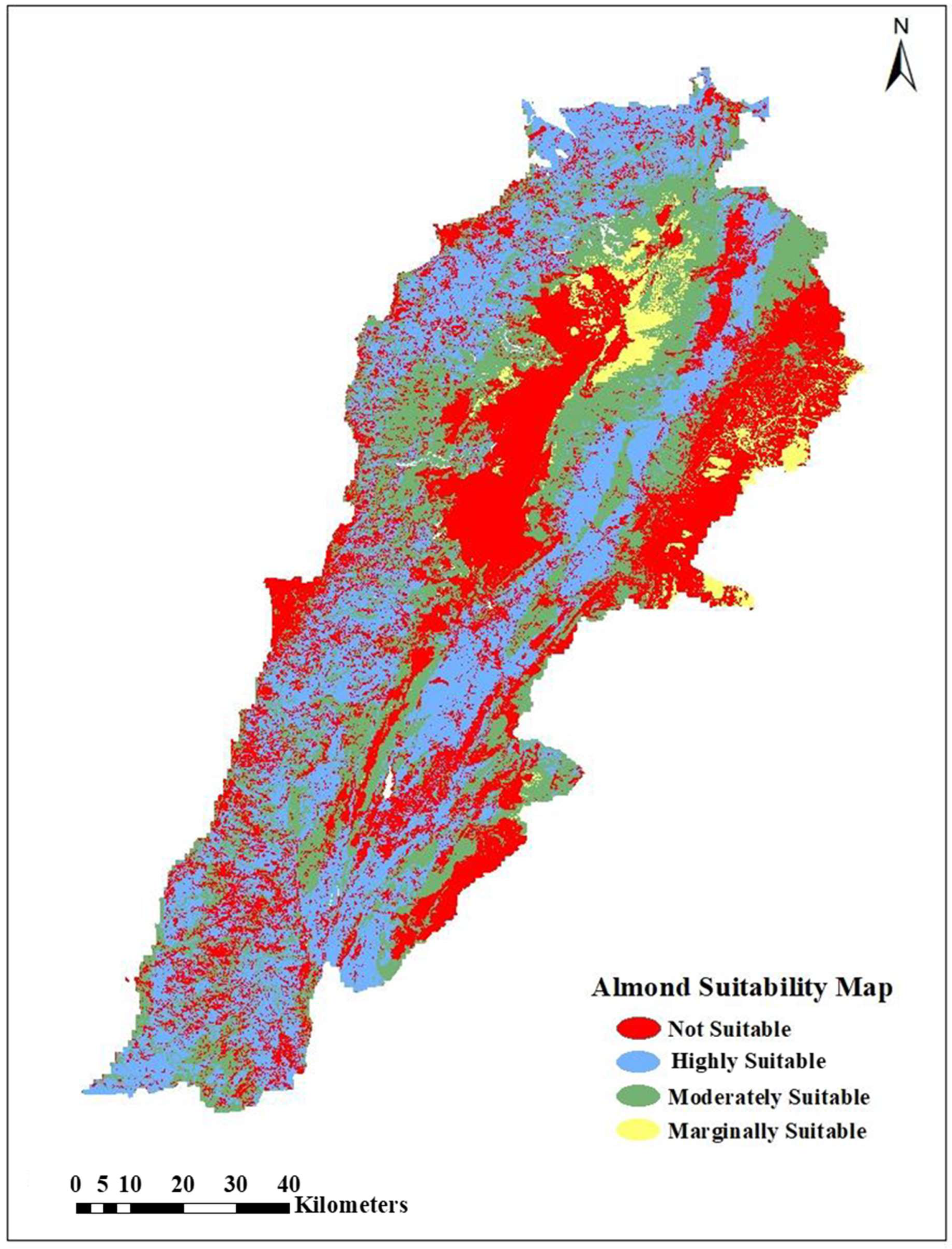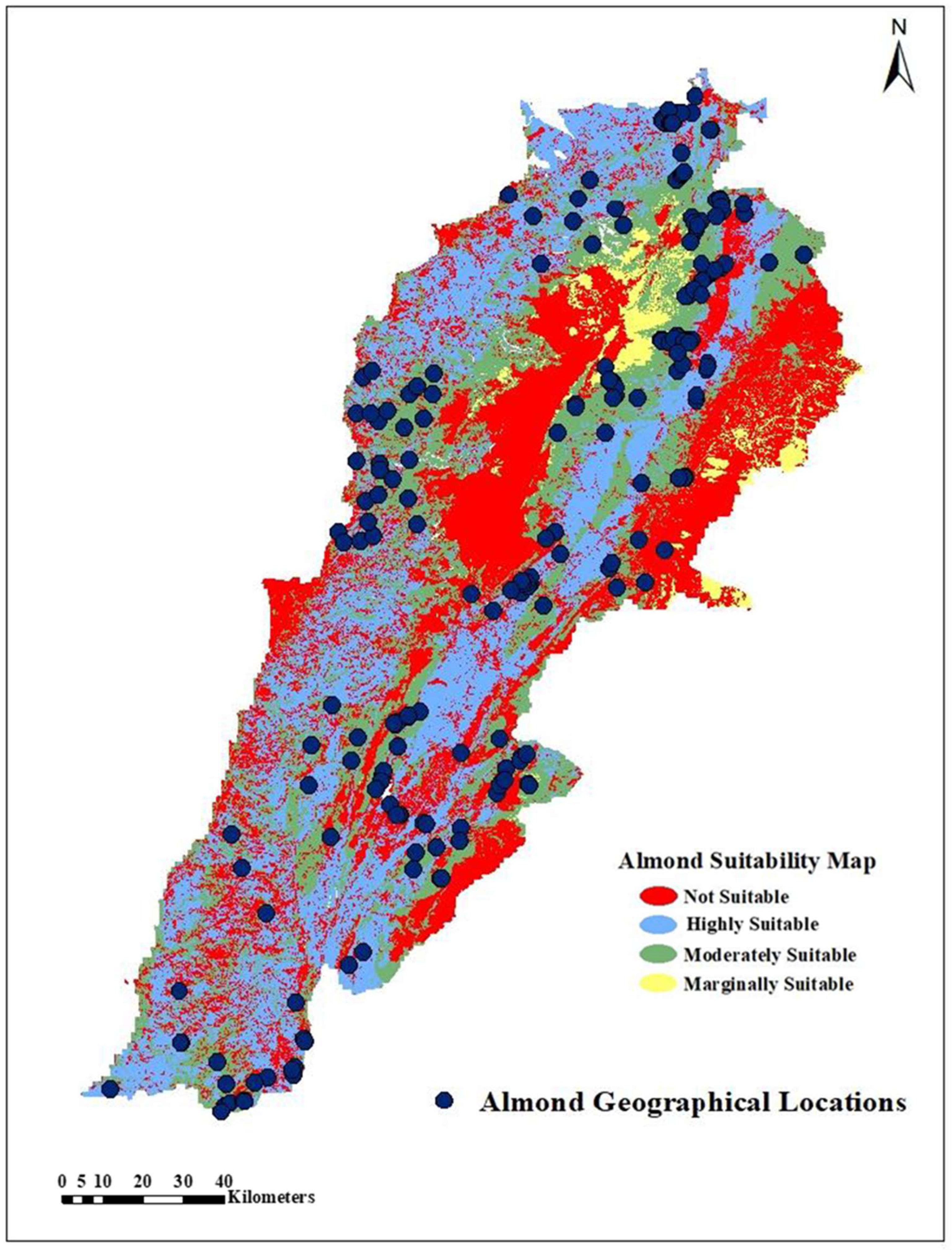GIS-Based Land Suitability Analysis for Sustainable Almond Cultivation in Lebanon
Abstract
1. Introduction
2. Materials and Methods
2.1. Site Description
2.2. Methodology Used
- “Highly suitable (S1): Land having no significant limitations to the sustained application of the considered use, or only minor limitations that will not significantly reduce productivity or benefits and will not raise inputs above an acceptable level.
- Moderately suitable (S2): Land having limitations that in aggregate are moderately severe for the sustained application of the considered use. The limitations will reduce productivity or benefits and increase the required inputs to the extent that the overall advantage to be gained from the use, although still attractive, will be appreciated as inferior to that in class S1 land.
- Marginally suitable (S3): Land having limitations which in aggregate are severe for the sustained application of the considered use and will reduce productivity or benefits or increase the required inputs to the extent that this expenditure will be only marginally justified.
- Not suitable (N): Land having limitations which appear very severe as to preclude any possibilities of successful sustained use of the land in the given manner, or the limitations may be surmountable in time but cannot be corrected with existing knowledge at the currently acceptable cost.
2.3. Identification of Criteria Influencing the Crop Suitability
- 1-
- Climate: precipitation and temperature;
- 2-
- Soil:
- -
- Physical properties: depth and texture;
- -
- Chemical properties: pH;
- 3-
- Topography: slope and elevation;
- 4-
- Current land use/land cover.
| Factors | Optimal Value for Almond/Almond Preferences | Bioclimatic Data (Downloaded from Different Sources) |
|---|---|---|
| Climatic Factors | ||
| Minimal temperature during December, January, February, and March | Cold needs to break the dormancy: the total number of hours below 7 °C The chill fraction is more tightly related to the mean winter temperature than the mean annual temperature [23,24] Beginning of blooming buds can resist until −3 °C and −4 °C [25,26] Full bloom stage: −1 °C and −2 °C are lethal Young fruits: −0.5 °C is lethal [27,28] | Minimal temperature from December to March Average monthly temperature in °C (mean T°) Source: http://worldclim.org/version2 (accessed on 14 March 2020) [29] |
| Precipitation | Minimal value: 400 mm [30] 400–1470 mm annual rainfall [28] With an optimum of 800 mm [30] Almond trees can survive on as little as 180 mm of water annually and respond to increased water applications with increasing yield [31,32] | Mean (Cumulative) Annual Precipitation (mm) Source: http://worldclim.org/version2 (accessed on 14 March 2020) [29] |
| Topographic Factors | ||
| Slope | >6% [5] | Slope Source: from DEM DEM from CNRS [33] |
| Elevation | <1200 m Optimum 750 m [34] | Altitude Source: from DEM DEM from CNRS [33] |
| Edaphic Factors | ||
| Soil Texture | Non-stratified, medium, and moderately fine-textured loamy soils [35] | Clay, Silt, Sand percentage Source: Soil map CNRS [33] |
| Soil Depth | >80 cm [27] | Soil depth Source: Soil map CNRS [33] |
| Soil pH | pH: 5.3–8.3 [28,36] limiting value: <5.0 | Soil pH Source: Soil map CNRS [33] |
2.4. Data Acquisition
2.5. Crop Requirement Characteristics and Criteria Layers Creation
- -
- Raster projection in the UTM Zone 36N coordinate system;
- -
- Creation of the raster layers: vector to raster geoprocessing tool (rasterization) for the depth, the pH, and the texture;
- -
- Resample: Change the spatial resolution of the raster dataset and set rules for aggregating or interpolating values across the new pixel sizes. The cell size of the raster data was 30 × 30;
- -
- Reclassification of the raster layers according to the four classes of suitability as described in the almond requirement table (Table 3). The numbers from 1 to 4 were applied to assign a code to the four suitability classes from highly suitable to not suitable, respectively.
- -
- Raster projection in the UTM zone 36N coordinate system;
- -
- Calculation of the slope raster in percentage;
- -
- Resample: Change the spatial resolution of the raster dataset and set rules for aggregating or interpolating values across the new pixel sizes. The cell size of the raster data is 30 × 30;
- -
- Reclassification of the raster layers according to the four classes of suitability as described in the almond requirement table (Table 3). The numbers from 1 to 4 are applied to assign a code to the four suitability classes from highly suitable to not suitable, respectively.
- -
- Download of the 12 tiles of precipitation and the four tiles of mean minimum temperature;
- -
- Clipping of the two climate tiles by the watershed boundaries;
- -
- Calculation of the mean annual precipitation and of the mean monthly minimum temperature of December, January, February, and March by using the raster calculator;
- -
- Resample: Change the spatial resolution of the raster dataset and set rules for aggregating or interpolating values across the new pixel sizes. The cell size of the raster data is 30 × 30;
- -
- Reclassification of the two-climate raster according to the four classes of suitability as defined in the almond requirements table (Table 3). The numbers from 1 to 4 are applied to assign a code to the four suitability classes from highly suitable to not suitable, respectively.
2.6. Criteria Maps Reclassification and Creation of the Almond Suitability Maps
- -
- Designation of the weights for the criteria: Soil features (pH, texture, and depth), precipitation, temperature, slope, elevation, and land use/land cover;
- -
- Weighted overlay analysis.
3. Results
3.1. Vocational Analysis of the Lebanon Land for Almond Cultivation
3.1.1. Creation of the Soil/Topography/Climate Suitability Maps
3.1.2. Land Occupancy
3.2. Almond Suitability Map
3.2.1. Criteria Weights Assignment
3.2.2. Suitability Map
4. Discussion
5. Conclusions
Author Contributions
Funding
Data Availability Statement
Acknowledgments
Conflicts of Interest
Abbreviations
| GIS | Geographic Information System |
| MCE | Multi-Criteria Evaluation |
References
- HelgiLibrary. Available online: https://www.helgilibrary.com/indicators/almond-production/lebanon/ (accessed on 21 February 2025).[Green Version]
- Fair Trade Lebanon. Value Chain Analysis of Almonds in Lebanon; Fair Trade Lebanon: Hazmiyeh, Lebanon, 2015; p. 25. Available online: https://fairtradelebanon.org/wp-content/uploads/2023/08/2015-Almonds-VCA-Akkar-and-Donniyeh-FTL.pdf (accessed on 12 July 2025).[Green Version]
- Chalak, L.; Chehade, A.; Kadri, A. Morphological characterization of cultivated almonds in Lebanon. Fruits 2007, 62, 177–186. Available online: https://fruits.edpsciences.org/articles/fruits/pdf/2007/03/i7306.pdf (accessed on 12 July 2025). [CrossRef]
- Hamadeh, B.; Chalak, L.; Coppens d’Eeckenbrugge, G.; Benoit, L.; Joly, H.I. Evolution of almond genetic diversity and farmer practices in Lebanon: Impacts of the diffusion of a graft-propagated cultivar in a traditional system based on seed-propagation. BMC Plant Biol. 2018, 18, 155. Available online: https://pubmed.ncbi.nlm.nih.gov/30081821/ (accessed on 12 July 2025). [CrossRef] [PubMed]
- Sahin, Y. The use of Geographical Information System (GIS) and Remote Sensing (RS) methods for the determination of the present and potential pistachio growing areas: Sanliurfa-Suruc case. Acta Hort. 2011, 912, 827–836. Available online: https://www.actahort.org/books/912/912_125.htm (accessed on 12 July 2025). [CrossRef]
- Akıncı, H.; Özalp, Y.; Turgut, B. Agricultural land use suitability analysis using GIS and AHP technique. Comput. Electron. Agric. 2013, 97, 71–82. [Google Scholar] [CrossRef]
- Singha, C.; Swain, C.K. Land suitability evaluation criteria for agricultural crop selection: A review. Agric. Rev. 2016, 37, 125–132. Available online: https://arccjournals.com/journal/agricultural-reviews/R-1588 (accessed on 12 July 2025). [CrossRef]
- Al-Shalabi, M.A.; Shattri, B.M.; Nordin, B.A.; Rashid, S. GIS based multicriteria approaches to housing site suitability assessment. In Proceedings of the Shaping the Change XXIII FIG Congress, Munich, Germany, 8–13 October 2006; Available online: https://www.fig.net/resources/Proceedings//fig_proceedings/fig2006/papers/ts72/ts72_05_alshalabi_etal%20_0702.pdf (accessed on 12 July 2025).
- Malczewski, J. GIS-based land-use suitability analysis: A critical overview. Prog. Plan. 2004, 62, 3–65. Available online: https://www.sciencedirect.com/science/article/abs/pii/S0305900603000801 (accessed on 12 July 2025). [CrossRef]
- Esfahlan, A.J.; Jamei, R.; Esfahlan, R.J. The importance of almond (Prunus amygdalus L.) and its by-products. Food Chem. 2010, 120, 349–360. [Google Scholar] [CrossRef]
- Ashwill, M.; Verner, D.; Christensen, J.; Mcdonnell, R.; Redwood, J.; Jomaa, I.; Saade, M.; Massad, R.; Chehade, A.; Bitar, A.; et al. Droughts and Agriculture in Lebanon: Causes, Consequences, and Risk Management; World Bank: Washington, DC, USA, 2018; p. 98. Available online: http://hdl.handle.net/10986/30595 (accessed on 12 July 2025).
- AbdelRahman, M.A.E.; Natarajan, A.; Hegde, R. Assessment of land suitability and capability by integrating remote sensing and GIS for agriculture in Chamarajanagar district, Karnataka, India. Egypt. J. Remote Sens. Space Sci. 2016, 19, 125–141. [Google Scholar] [CrossRef]
- Awad, M.M. Suitability analysis for stone pine reforestation using geospatial technologies. Int. J. Adv. Remote Sens. GIS 2015, 4, 1008–1018. [Google Scholar] [CrossRef][Green Version]
- Chalak, L.; Sabra, N. Country Report on the State of Plant Genetic Resources for Food and Agriculture; FAO: Rome, Italy, 2007; p. 60. Available online: https://www.fao.org/4/i1500e/Lebanon.pdf (accessed on 12 July 2025).[Green Version]
- Carver, S.J. Integrating multi-criteria evaluation with Geographical Information Systems. Int. J. Geogr. Inf. Syst. 1991, 5, 321–339. [Google Scholar] [CrossRef]
- Joerin, F.; Thériault, M.; Musy, A. Using GIS and outranking multicriteria analysis for land-use suitability assessment. Int. J. Geogr. Inf. Sci. 2001, 15, 153–174. [Google Scholar] [CrossRef]
- Pereira, J.M.C.; Duckstein, L. A multiple criteria decision-making approach to GIS-based land suitability evaluation. Int. J. Geogr. Inf. Syst. 1993, 7, 407–424. [Google Scholar] [CrossRef]
- FAO. A Framework for Land Evaluation—Chapter 3: Land Suitability Classifications; FAO Soils Bulletins: Rome, Italy, 1976; Volume 32, Available online: http://www.fao.org/3/x5310e/x5310e04.htm (accessed on 12 July 2025).
- Mendoza, G.A.; Prabhub, R. Multiple criteria decision-making approaches to assessing forest sustainability using criteria and indicators: A case study. For. Ecol. Manag. 2000, 131, 107–126. [Google Scholar] [CrossRef]
- Longley, P.A.; Goodchild, M.F.; Maguire, D.J.; Rhind, D.W. Geographical Information Systems: Principles, Techniques, Management and Applications; John Wiley: New York, NY, USA, 1999; p. 480. Available online: https://www.geos.ed.ac.uk/~gisteac/gis_book_abridged/files/00_fm.pdf (accessed on 12 July 2025).
- Opon, J.; Henry, M. A multicriteria analytical framework for sustainability evaluation under methodological uncertainties. Environ. Impact Assess. Rev. 2020, 83, 106403. [Google Scholar] [CrossRef]
- Malczewski, J. A GIS-based approach to multiple criteria group decision-making. Int. J. Geogr. Inf. Syst. 1996, 10, 955–971. [Google Scholar] [CrossRef]
- Thomas, D. Managing Almond Production in a Variable and Changing Climate. In Hort Innovation: Final Report; Horticulture Innovation Australia Limited: Sidney, Australia, 2019; Available online: https://prod2.horticulture.com.au/globalassets/laserfiche/assets/project-reports/al14006/al14006---final-report-complete.pdf (accessed on 12 July 2025).
- Guillamón, J.G.; Egea, J.; Mañas, F.; Egea, J.A.; Dicenta, F. Risk of Extreme Early Frosts in Almond. Horticulturae 2022, 8, 687. [Google Scholar] [CrossRef]
- Masip, D.; Torguet, L.; Batlle, I.; Alegre, S.; Miarnau, X. Almond fruit tolerance to frost temperatures in new Spanish cultivars. Acta Hort. 2018, 1219, 67–72. [Google Scholar] [CrossRef]
- Calle, A.; Barba, P.G.; Torguet, L.; Giné-Bordonaba, J.; Reig, G.; Miarnau, X. Understanding Flower Frost Tolerance in Almond (Prunus dulcis): The Role of Phenology, Cultivar and Sugars Content. J. Agron. Crop Sci. 2025, 211, e70090. [Google Scholar] [CrossRef]
- Grasselly, C.; Crossa-Raynaud, P. L’Amandier; G.-P. Maisonneuve et Larose: Paris, France, 1980; p. 446. [Google Scholar]
- Lim, T.K. Prunus dulcis. In Edible Medicinal and Non-Medicinal Plants; Springer Nature: Berlin/Heidelberg, Germany, 2012; Volume 4, pp. 480–491. [Google Scholar] [CrossRef]
- Fick, S.E.; Hijmans, R.J. WorldClim 2: New 1-km spatial resolution climate surfaces for global land areas. Int. J. Climatol. 2017, 37, 4302–4315. Available online: http://worldclim.org/version2 (accessed on 14 August 2025). [CrossRef]
- Alaoui, S.B. Référentiel Pour la Conduite Technique de L’amandier (Prunus Amygdalus Batsh); ResearchGate: Berlin, Germany, 2005. [Google Scholar] [CrossRef]
- Baspinar, H.; Doll, D.; Rijal, J. Pest management in organic almond. In Handbook of Pest Management in Organic Farming; Vacante, V., Kreiter, S., Eds.; CABI: Boston, MA, USA, 2018; pp. 328–347. Available online: https://www.researchgate.net/publication/322750268_Pest_Management_in_Organic_Almondsv (accessed on 12 July 2025).
- Sperling, O.; Kamai, T.; Gardi, I.; A Zwieniecki, M.; Marino, G. Modeling tree responses to soil water variability guides irrigation to account for soil winter reserves. Vadose Zone J. 2025, 24, e20385. [Google Scholar] [CrossRef]
- CNRS, Remote Sensing Center, National Council for Scientific Research. New Detailed Soil Map of Lebanon, Scale 1:50,000; Remote Sensing Center, CNRS: Beirut, Lebanon, 2006; Available online: https://www.cnrs.edu.lb (accessed on 14 August 2025).
- LARI, and MoA. (2008). اللوز Agricultural Development Project (Report) MED/2003/5715/ADP.
- Socias i Company R.; Alonso, J.M.; Kodad, O.; Gradziel, T.M. Almond. In Fruit Breeding. Handbook of Plant Breeding; Badenes, M., Byrne, D., Eds.; Springer: Boston, MA, USA, 2012; Volume 8, pp. 697–728. [Google Scholar] [CrossRef]
- De LaTaille, R. Les Arbres à Fruits Secs; Flammarion: Paris, France, 1985; p. 207. Available online: http://catalogue.bnf.fr/ark:/12148/cb34777353p (accessed on 12 July 2025).
- Hijmans, R.J.; Cameron, S.E.; Parra, J.L.; Jones, P.G.; Jarvis, A. Very high resolution interpolated climate surfaces for global land areas. Int. J. Climatol. 2005, 25, 1965–1978. [Google Scholar] [CrossRef]
- Muhammad, S.; Saa, S.; Khalsa, S.D.S.; Weinbaum, S.; Brown, P. Almond tree nutrition. In Almonds: Botany, Production and Uses; Socias i Company R., Gradizel, T.M., Eds.; CABI: Wallingford, UK, 2017; pp. 291–320. [Google Scholar]
- FAO. Guidelines for Soil Description, 4th ed.; FAO: Rome, Italy, 2006; Available online: http://www.fao.org/3/a0541e/a0541e.pdf (accessed on 12 July 2025).
- Ahmad, F.; Goparaju, L. Land evaluation in terms of agroforestry suitability, an approach to improve livelihood and reduce poverty. A FAO based methodology by geospatial solution: A case study of Palamu district, Jharkhand, India. Ecol. Quest. 2017, 25, 67–84. [Google Scholar] [CrossRef]
- Kester, D.E.; Gradziel, T.M.; Grasselly, C. Almonds (Prunus). Acta Hort. 1991, 290, 701–731. [Google Scholar] [CrossRef]
- Darwish, T.; Jooma, I.; Awad, M.; Aboudaher, M. Inventory and management of Lebanese soils integrating the soil geographical database of Euro-Mediterranean countries. Leb. Sci. J. 2005, 6, 57–70. Available online: https://lsj.cnrs.edu.lb/wp-content/uploads/2015/12/darwich-short.pdf (accessed on 12 July 2025).
- Belay, F.; Islam, Z.; Tilahun, A. Application of the overlay weighted model to determine the best locations for expansion of Adigrat town. Indo-Afr. J. Res. Manage Plan. 2015, 3, 1–9. Available online: https://www.researchgate.net/publication/317402248_Application_of_the_overlay_weighted_model_to_determine_the_best_locations_for_expansion_of_adigrat_town#fullTextFileContent (accessed on 12 July 2025).
- Walke, N.; Obi Reddy, G.P.; Maji, A.K.; Thayalan, S. GIS-based multicriteria overlay analysis in soil-suitability evaluation for cotton (Gossypium spp.): A case study in the black soil region of Central India. Comput. Geosci. 2012, 41, 108–118. [Google Scholar] [CrossRef]
- Jin, Y.; Chen, B.; Lampinen, B.D.; Brown, P.H. Advancing Agricultural Production with Machine Learning Analytics: Yield Determinants for California’s Almond Orchards. Front. Plant Sci. 2020, 11, 290. Available online: https://pubmed.ncbi.nlm.nih.gov/32231679/ (accessed on 12 July 2025). [CrossRef]
- Wang, W.; Li, Z.J.; Zhang, Y.L.; Xu, X.Q. Current Situation, Global Potential Distribution and Evolution of Six Almond Species in China. Front. Plant Sci. 2021, 12, 619883. Available online: https://oa.mg/work/10.3389/fpls.2021.619883 (accessed on 12 July 2025). [CrossRef]
- Karami, A.; Salehi, A.; Aliyari, V. Land Suitability Evaluation for Almond Cultivation in Fars Province, Iran; AGRIS; Ferdowsi University of Mashhad: Mashhad, Iran, 2025; Volume 16, pp. 683–711. Available online: https://agris.fao.org/search/en/providers/122436/records/67bca635e27dfa1251896b62 (accessed on 12 July 2025).
- Gutiérrez-Gordillo, S.; García-Tejero, I.F.; García-Escalera, A.; Galindo, P.; Arco, M.D.C.; Zuazo, V.H.D. Approach to yield response of young almond trees to deficit irrigation and biostimulant applications. Horticulturae 2019, 5, 38. [Google Scholar] [CrossRef]
- Benmoussa, H.; Ghrab, M.; Ben, M.; Luedeling, E. Chilling and heat requirements for local and foreign almond (Prunus dulcis Mill.) cultivars in a warm Mediterranean location based on 30 years of phenology records. Agric. For. Meteorol. 2017, 239, 34. [Google Scholar] [CrossRef]
- Mugo, J.W.; Kariuki, P.C.; Musembi, D.K. Identification of Suitable Land for Green Gram Production Using GIS Based Analytical Hierarchy Process in Kitui County, Kenya. J. Remote Sens. GIS 2016, 5, 170. [Google Scholar] [CrossRef]
- Deng, F.; Li, X.; Wang, H.; Zhang, M.; Li, R.; Li, X. GIS-based assessment of land suitability for alfalfa cultivation: A case study in the dry continental steppes of northern China. Span. J. Agric. Res. 2014, 12, 364–375. [Google Scholar] [CrossRef]
- Parker, L.E.; Abatzoglou, J.T. Shifts in the thermal niche of almond under climate change. Clim. Change 2018, 147, 211–224. [Google Scholar] [CrossRef]
- Freitas, T.R.; Santos, J.A.; Silva, A.P.; Fonseca, A.; Fraga, H. Evaluation of historical and future thermal conditions for almond trees in north-eastern Portugal. Clim. Change 2023, 176, 89. [Google Scholar] [CrossRef]








| Class | Description | % |
|---|---|---|
| 1 | Flat | 0–0.2 |
| 2 | Level | 0.2–0.5 |
| 3 | Nearly Level | 0.5–1.0 |
| 4 | Very gently sloping | 1.0–2.0 |
| 5 | Gently sloping | 2–5 |
| 6 | Sloping | 5–10 |
| 7 | Strongly sloping | 10–15 |
| 8 | Moderately steep | 15–30 |
| 9 | Steep | 30–60 |
| 10 | Very steep | >60 |
| Factor/Criterion | Highly Suitable (S1) | Moderately Suitable (S2) | Marginally Suitable (S3) | Not Suitable (N) |
|---|---|---|---|---|
| Rainfall (mm) Mean Annual Precipitation | >650 mm | 450–650 mm | 350–450 mm | <350 mm |
| Temperature (°C) Average minimum temperature (tmin) during December, January, February, and March | 2–7 °C | −0.25–2 °C | >7 °C | <−0.25 °C |
| Slope (%) | 5–25% | <5% | 25–35% | >35% |
| Elevation (m) | ≤1200 | 1200–1600 | 1600–2000 | >2000 |
| Soil Texture (class) | Loam Silty loam Silty clay loam Sandy clay loam Silty clay loam | Sandy loam | Loamy sand Sandy clay Silty clay | Sandy Clay |
| Soil Depth (cm) | ≥100 cm | 80–100 cm | 50–80 cm | ≤50 cm |
| Soil pH | 7–8 | 6 | 5 | <5 and ≥9 |
| Parameter | Symbol | Weight (%) |
|---|---|---|
| Rainfall | R | 20 |
| Temperature | T | 20 |
| Texture | Tx | 10 |
| Depth | D | 10 |
| pH | pH | 5 |
| Elevation | E | 25 |
| Slope | S | 10 |
Disclaimer/Publisher’s Note: The statements, opinions and data contained in all publications are solely those of the individual author(s) and contributor(s) and not of MDPI and/or the editor(s). MDPI and/or the editor(s) disclaim responsibility for any injury to people or property resulting from any ideas, methods, instructions or products referred to in the content. |
© 2025 by the authors. Licensee MDPI, Basel, Switzerland. This article is an open access article distributed under the terms and conditions of the Creative Commons Attribution (CC BY) license (https://creativecommons.org/licenses/by/4.0/).
Share and Cite
Elbared, P.; Nassif, N.; Hassoun, G.; Mulas, M. GIS-Based Land Suitability Analysis for Sustainable Almond Cultivation in Lebanon. Agriculture 2025, 15, 1974. https://doi.org/10.3390/agriculture15181974
Elbared P, Nassif N, Hassoun G, Mulas M. GIS-Based Land Suitability Analysis for Sustainable Almond Cultivation in Lebanon. Agriculture. 2025; 15(18):1974. https://doi.org/10.3390/agriculture15181974
Chicago/Turabian StyleElbared, Pascale, Nadine Nassif, Georges Hassoun, and Maurizio Mulas. 2025. "GIS-Based Land Suitability Analysis for Sustainable Almond Cultivation in Lebanon" Agriculture 15, no. 18: 1974. https://doi.org/10.3390/agriculture15181974
APA StyleElbared, P., Nassif, N., Hassoun, G., & Mulas, M. (2025). GIS-Based Land Suitability Analysis for Sustainable Almond Cultivation in Lebanon. Agriculture, 15(18), 1974. https://doi.org/10.3390/agriculture15181974






